
I’m standing in an opulent living room in Palm Beach, Florida. Gold adorns the furniture, crystal adorns the chandeliers and a photograph of Donald Trump in a gilded frame adorns the mantelpiece. Bounding around next to me is a coiffed poodle named Stormy, gnawing on Lulu, his favourite toy sheep. We are all waiting for Toni Holt Kramer to come down the marbled stairway.
Suddenly, there’s a clatter and Kramer, all Versace perfume and bouncy blonde hair, emerges from an elevator hidden behind a regular-looking door.
“Oh, hi. Hello. I didn’t know you were making an entrance that way. I thought you’d be . . . ” I say, gesturing towards the stairs.
“I do sometimes,” Kramer says. “But it’s so much quicker this way, especially when you have heels on.” She smiles, her plump, thickly lined, glossy lips revealing perfect platinum white teeth, and offers me a seat while Jose, her Mexican “chief of staff”, brings us water. Kramer pets Stormy affectionately — he is named after a rainstorm that took place the day he arrived at the dog shelter, rather than the porn star with whom Trump had an affair and who was paid $130,000 just before the 2016 election to keep quiet. She tells him, in French, to sit down.
Kramer is the leader of the “Trumpettes”, a group of superfans that she and a friend dreamt up during a cruise around the Mediterranean in 2015. (She’d been lobbying Trump to run for office, writing him regular letters to urge him on and calling him “Mr President”, long before a political career was seriously in his sights.) There are now thousands of Trumpettes around the world. The original goal, Kramer tells me, was “to acquaint women with the fact that they needed to elect Donald Trump”. Now it’s to get him re-elected in 2024. “We have to help him save America,” Kramer says. “Make America great again. Make America safe again. Make America prosperous again.”
Although the Trumpettes were formed by a small group of wealthy friends who seem to spend a lot of time attending charity galas, Kramer scoffs at the idea that she is a socialite. “Honey, I’ve been working since I was eight years old.” She tells me her father was a “degenerate gambler” who left when she was a child and that she was brought up by her mother and aunt in New York. When she was 15, she got a job as a dancer at the Copacabana, the nightclub lionised by Barry Manilow. Later, Kramer became a celebrity interviewer and had a 30-year career that included hosting her own syndicated talk show, Toni Holt in Hollywood. When I ask how old she is, she says, “Joan Collins once said if a woman will tell you her age, she will tell you anything. So that’s my answer. I have no age.”

In 1992, she married Bobby Kramer, now 96, who’d made a fortune selling cars. Kramer might be rich these days, but she is far from being a lady of leisure. She spends her weekdays trading stocks and options and is prolifically pro-Trump on social media. “I’m not a lady who lunches. I’m not one who likes to play cards,” she says. “I value time. I love work.” She also says she “can’t stand stupid” and later points out the sign on the door to her office that reads: “WARNING: NO STUPID PEOPLE BEYOND THIS POINT”.
Kramer has long voted Republican, though she has a soft spot for Hillary Clinton, whom she knew before she knew Trump. She organised a fundraising event for Clinton when she was a senator in the early 2000s, back in the days when the Clintons themselves were on good terms with Trump. Despite not having spoken to Hillary since Trump defeated her, Kramer still considers her a friend. “I like women who think,” she says. “I like women who act.”
Her stated dislike of lunching notwithstanding, Kramer has agreed to organise a “luncheon” for me at the Trumpettes’ unofficial headquarters, Mar-a-Lago. Trump’s private club — a sprawling complex centred around a 62,500-sq-ft, 114-room mansion with a spa, two ballrooms, various indoor and outdoor eating areas and a beach club — isn’t easy to get into. When Trump became president, initiation fees for members rose to $200,000, and several members told me they have since increased considerably. (A spokesperson for the club did not respond to requests for comment.) Since 2019, Mar-a-Lago has been Trump’s primary residence, his staging ground, his court. My curiosity about how the club’s social circle operates post-presidency brought me to Kramer.
In the wake of the US midterm elections on November 8, Trump hasn’t seemed the electoral force he once was. Many of the candidates he endorsed foundered at the ballot box, and a raft of election deniers who embraced his lies about Joe Biden’s victory in 2020 were rejected by voters. Conservative media, including some presenters on the Murdochs’ Fox News, seemed to walk away from the former president. And then there’s the looming presence of Florida governor Ron DeSantis, Trump’s former Maga understudy, who looks increasingly likely to challenge him for the 2024 nomination.
By the time I sit down with Kramer, Trump has publicly promised to make “a very big announcement” at the club the following Tuesday. The Trumpettes will, of course, be there to cheer him on. As I leave, I ask if I can come along. Kramer says she’ll have to see, before impressing on me what she really wants me to take away: Trump is still a force to be reckoned with, and he has “unfinished business”. “He is a winner,” she says, pointing her finger at me. “Losing is against his entire personality, and it is unacceptable in his own mind. He’ll never quit.”
A few days later, I arrive at Mar-a-Lago for the first time. I’m in an Uber, which isn’t done. My driver is informed by a security guard, in no uncertain terms, that ride-shares are not permitted inside the gates. So I get out and walk sheepishly up the driveway in the blistering, mid-day heat.
Mar-a-Lago is a genuine American article. Built in the late-1920s by cereal heiress Marjorie Merriweather Post, the richest woman in the US at the time, the estate was designed with history in mind. When she died in 1973, Post left the 17-acre property to the US government to serve as a “Winter White House”. But less than a decade later, the federal bureaucracy returned it to the family’s foundation, citing immense maintenance costs. Trump managed to buy it for about $10mn — it had been listed at $20mn — in 1985 and turned it into a club in the mid-1990s. Nowadays it is reckoned to be worth a few hundred million dollars.
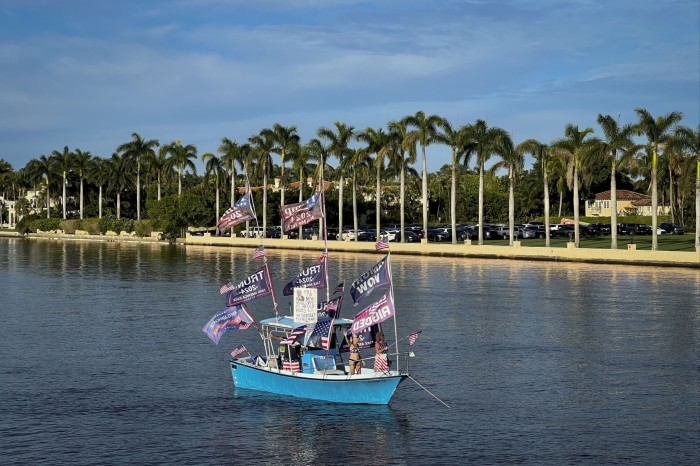
During Trump’s presidency, Mar-a-Lago finally became the Winter White House. He spent every weekend he could there and held meetings with world leaders including Xi Jinping and Shinzo Abe in the public dining areas, in full view of other guests. Since 2020, it has become a unique home base for the former president, part social club, part political nerve centre for a man whose obsession with winning threatens to split the Republican base.
When I get there, I’m not asked for any proof of identity, nor is my bag checked. I find Kramer sitting at a table on the patio overlooking the pool, the palm-tree-dotted gardens and, beyond, the Intercoastal Waterway — the “lago” that separates Palm Beach from the relatively less affluent West Palm Beach. She’s at a table under a yellow-and-white striped canopy, with three other Trumpettes. I sit down next to her and order a Bloody Mary. Our napkins are imprinted with the same coat of arms that can be found all over the property, whose blazon Trump changed from “Integritas” to “Trump” when he took it over. In the distance, a man sails past on a boat with a large flag that reads: “TRUMP WON”. I point it out to the others. “Oh yes, we have a lot of that here. It’s probably left over from one of those Trump boat parades,” Kramer says, uninterested.
There are only about a dozen or so other people having lunch. Although Mar-a-Lago opens to its members for “the season” at Halloween, many don’t come to Palm Beach until after Thanksgiving. The guests are a mixture of the kind of older couples I had expected and some surprisingly young members. Their wealth is palpable. Guns N’ Roses’ “November Rain” is playing, when the volume is suddenly turned up several notches. Applause breaks out on the patio, and then there are cheers of “We love you!” A tall man wearing a red Maga cap and golfing clothes, flanked by secret service agents, is talking on his iPhone and heading in our direction.
The man is Trump.
He sees Kramer and shoves his iPhone to her ear: “It’s Sean Hannity.”
“Oh, hello Sean, how are you?” Kramer says into the phone. “You know we’re going to have our fourth annual Celebrating Trump event coming up. And we are on the march. We are getting him back in the White House. And you’re the best — I watch you every night. Thank you.”
Trump takes back the phone. “She’s worth millions of dollars,” he tells Hannity. “She’s got a ring on her that’s worth $25 million; it’s 48 carats.” One of the other Trumpettes asks him if his daughter Tiffany Trump, who had her wedding at Mar-a-Lago the previous evening, had been given a diamond as big as Kramer’s, which is, it must be said, the biggest rock I have ever seen. “Tiffany’s is not as big,” Trump says. Everybody laughs.
Hannity is still on the other end of the line. “Sean, I gotta go,” Trump says. “You know I’m getting that award tonight from the Zion — I’m a Zionist! No I’m not. I’m so late.” He hangs up.
“You’re the best, is what you are,” says Kramer. “You’re worth waiting for!” shouts another Trumpette. Trump is looking relaxed after a morning on his golf course in West Palm Beach, despite reports that he is still fuming about the results of the midterms. He looks like he’s lost weight. He’s not looking as orange as usual and is brimming with energy. He does his trademark dance for us: pulling a face, fists pumping side-to-side.
I tell him that I work for the Financial Times. “Oh, that’s very good. Great power,” Trump says, patting the back of my chair. “Are you doing a story?”
“I’m doing a story on Mar-a-Lago, and I’m hoping to come on Tuesday.”
“This is the hottest place,” he boasts. “OK, you wanna come? Should I let her come?” he asks the table, hamming it up.
“Why not?” Kramer says.
“OK, anyone Toni says can come,” Trump says, before walking off towards the living quarters he shares with his wife Melania and their son Barron. The Trumps’ home is located in a modest-sized building that can only be accessed by walking through Mar-a-Lago’s public areas, something Trump seems just fine with.
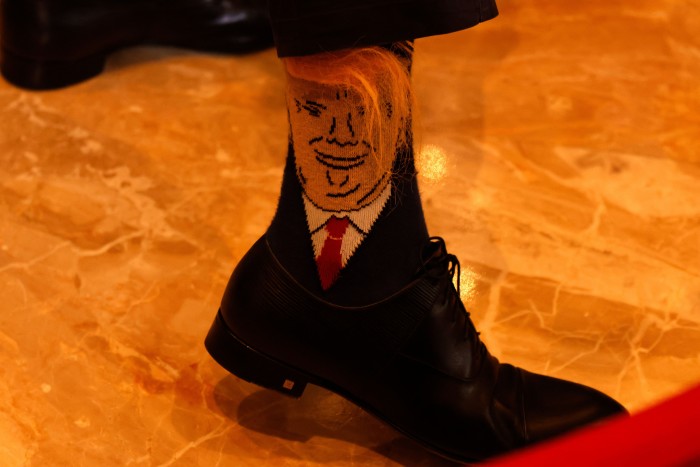
About 20 minutes later, on my way back from the restroom, I bump into the ex-president again. He is walking through the patio, this time in a tuxedo, ready to fly to New York to receive his award from the Zionist Organization of America. More applause and shouts of appreciation from guests: “We love you, Mr President!”
At Mar-a-Lago, Trump really is still the president. But he’s more than that. “No other president in the history of the United States will be like Trump,” one club member tells me. “Trump’s the president. He runs the country, but he’s also the king. There’s no other president that will be the king.” I ask if I can quote him on that by name, but he declines. “Some readers won’t like that. Some readers don’t like royalty.” He shakes his head sadly. “The world is changing a lot.”
Two days later, I am having lunch a few mansions down from Mar-a-Lago at the home of Thomas Peterffy, founder and chairman of Interactive Brokers. Peterffy, 78, came to America from Hungary when he was 21, with no money and no English. Now, he is estimated by Bloomberg to be worth nearly $25bn, making him the richest man in Florida. Peterffy might live in one of the wealthiest zip codes in the country, but he is far from flashy. He drives a Lexus and is wearing a casual shirt and trousers with a pair of hiking shoes.
Peterffy voted for Trump twice and donated to his 2020 campaign but is now firmly in the DeSantis camp. He threw the up-and-coming governor a fundraiser in the garden where we’re now eating sea bass and drinking rosé. He is dismayed by Trump’s imminent 2024 announcement. “It’s extremely unfortunate, because he’s extremely likely to win the primary, and there’s no way he can win the general,” Peterffy says, taking a piece of bread and spreading it thickly with butter. “So, we have to get together and somehow make sure that he is not going to be the Republican candidate.”
“Who is ‘we?’” I ask.
“Big donors . . . The next election is going to be very important.”
“And very expensive?”
“Very expensive.”
I ask him how much he is willing to spend on DeSantis, who, having decisively won re-election earlier in the month, is the only nationally known Republican with a chance of taking on Trump in the primaries. I get the sense that there is no limit.
As we talk, I spot a large, yellow-green iguana with a striped tail slowly making its way along the garden wall. I point it out excitedly because I am from England, and this is an exotic creature.
Peterffy gets up without saying anything and makes his way inside. After a minute or so, he reappears holding an enormous gun, aims and begins shooting. Pop. Pop. Pop. Pop. I turn away. Pop. Pop. Pop. Peterffy puts his weapon away and comes back to the table.
“Oh my God,” I say. “Did you get him?”
“Sure. It’s an airgun. It shoots out little aluminium pellets, so if I put about five or six into him he’s gonna die.”
Peterffy is a member of Mar-a-Lago, but says he hardly goes and only joined because it’s so close to his home. “One thing about Mar-a-Lago members is they tend to be ostentatious,” he says. “Most of my friends go to other clubs. Most of the people we know belong to the Everglades or Club Colette,” he says, referring to two members-only clubs that predate Mar-a-Lago. “People there have smaller jewellery, and they are less loud.”
Across the road from Peterffy and even closer to Mar-a-Lago lives his good friend Jeff Greene, another multibillionaire who joined the club back in 2010. Greene, 67, made his money shorting subprime mortgages in the lead-up to the 2008 financial crisis and has since then made two unsuccessful runs for political office as a Democrat, first in the 2010 primary for one of Florida’s US Senate seats and then in the party’s 2018 primaries to run against DeSantis for governor.
Greene says he had felt unwelcome at many of the longer-established clubs in Palm Beach, but not at Mar-a-Lago. He was on good terms with Trump back then, though the two were never really friends. “He would come over to my table, I think because I was a billionaire. He likes billionaires,” Greene says, his feet up on his desk as he talks to me. “That’s a big deal to him. He likes people who are rich and famous.”
Greene doesn’t seem to mind the rich and famous either. His office walls are covered with pictures of himself posing with Whitney Houston, Jeff Bezos and Tony Blair. His best friend is Mike Tyson, he says. There are pictures with him too, and with Trump. But the relationship with Trump soured after his gubernatorial campaign, during which he released ads critical of the president. Greene thought the ads were just politics. But in early 2020, he was playing golf with a friend at the Trump course in West Palm Beach, when he ran into Trump at the 16th hole. “He looks at me and he goes, ‘What a nerve you have coming to this club!’ Then he just drives away.” A little later, in the club’s grill room, Trump’s anger seemed to grow. “He looks me in the eye and he goes, ‘You know, you spent all that money, millions and millions of dollars, and came in fourth. What a loser!’ In front of all of my friends.”
I ask Greene who Trump’s closest friends are at Mar-a-Lago. “I don’t think he has any friends . . . I mean honestly, I have this friend who . . . plays golf with him all the time but you know, he never went to the White House. I don’t even think he was even invited.” At Mar-a-Lago, though, Trump seems constantly surrounded by people who love him. “It’s all transactional. They want to be around him because he’s the ex-president,” says Greene. “He likes people to defer to him . . . and tell him how good he is.”
One person who does consider Trump a “good friend” is Brexit-party-leader-turned-GB-News-host Nigel Farage, who I had bumped into a few weeks earlier on the sidelines of a bitcoin conference. He told me that he had been to Mar-a-Lago seven or eight times to see Trump. “The big moment in our relationship, I suppose, was when I got up on stage in Mississippi in August ’16,” Farage told me. “He shook my hand on stage and said to me, ‘You will be my friend for life.’ And he meant it. He meant it. We could pick up the phone and ring him now.”
I’d asked Farage whether his friend Trump had charged him for his Mar-a-Lago visits. “Oh I can’t remember. Probably,” he laughed. “I don’t answer questions like that.”
On Tuesday, ahead of Trump’s big announcement, I am at Le Bazaar, a high-end salon in Palm Beach. A woman named Angel, whom I know from London, has offered me a free colour and blow dry. I realise there are at least four people here who are going to Mar-a-Lago later. Two of them are club members who’ve flown in from Los Angeles; one is a relative of Trump’s and the other is Natalie Winters, co-host and executive editor of Steve Bannon’s War Room podcast. She’s very friendly: “Oh you’re from the Financial Times. That’s Steve’s favourite.”
When I arrive at Mar-a-Lago around 7.30pm, the party is already in full swing. The dining room is abuzz, and the tables on the patio are packed. I spot Kramer at a large, round table outside. She’s in her full Trumpettes get-up: a bright red dress, red headband, red heels and a white sash with the word “Trumpettes” emblazoned on it. I sit down beside her and tell the waitress I’ll have what she’s having, straight-up Belvedere Vodka with ice.
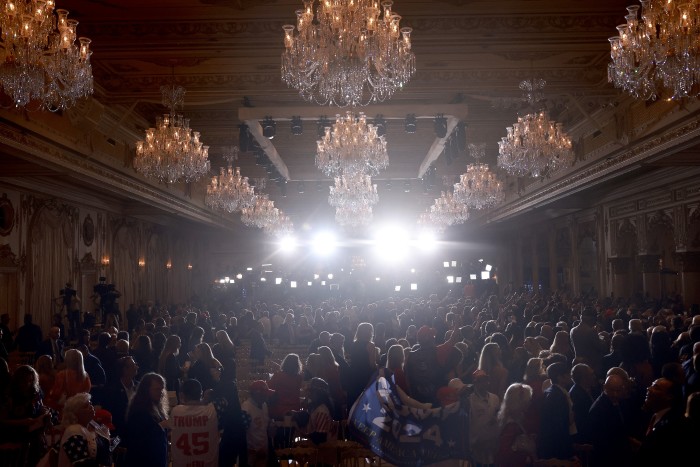
Trump’s son Eric is at the next table, chatting with a small group of people. Eric’s wife Lara, a Fox News contributor, is also here somewhere and will be seated in the front row for Trump’s speech. Kramer leans into me so that I can hear her over the blasting of “Bye Bye Bye” by NSYNC. “Over there is Gina Rinehart,” she says, motioning towards a woman draped in pink chiffon and pearls at the table behind me. “She’s one of the most illustrious, important human beings in all of Australia.” Rinehart, a mining magnate known for being Australia’s richest person, is an “honorary Trumpette”, Kramer explains.
A portly man who looks like the stereotype of a 1930s crime boss, a fat cigar hanging out of his mouth, walks towards our table. A blonde woman in her seventies, wearing a white jacket adorned with diamond butterfly brooches, hangs on his arm. “This is the wonderful JJ,” Kramer says, introducing us. “Say hello to Jemima Kelly. She’s from the London Financial Times.”
Kramer explains that the couple is John “JJ” Cafaro and his wife Janet. JJ, a 70-year-old shopping mall developer from Ohio, also pleaded guilty to bribing a congressman back in 2001. “Janet and JJ are very, very, very, very dear friends of the president and major supporters of the president, and they will not rest until the president is back in the White House,” Kramer tells me. “He’s been my friend for 50 years,” JJ says proudly.
Kramer pulls my arm. “There’s Jared [Kushner],” she says, pointing towards Trump’s son-in-law, who is wandering around the patio.
A man with bright white hair and a thick German accent begins sternly telling guests that it is time to leave — it is almost 8.30pm — and head down to the Grand Ballroom for the announcement. The man is Bernd Lembcke, Mar-a-Lago’s managing director who runs the club with an iron fist and who I have been advised not to even approach. “That’s the scary German we’re all afraid of,” a woman sitting at my table tells me.
Kramer and I make our way to the ballroom, where Trump’s former adviser Roger Stone is posing for photos with fans near the entrance. Stone, who was convicted of seven felony counts in 2019 as part of Robert Mueller’s investigation into 2016 election interference, is standing opposite the staircase that leads to Trump’s office, where the FBI found classified documents during an August raid on Mar-a-Lago.
The ballroom, which feels more like a conference hall due to its vast scale and garish lighting, is packed. Madison Cawthorn, the 27-year-old Republican Congressman from North Carolina, is trying to make his way through the throng in his wheelchair. Cawthorn’s tenure was distinguished by a number of controversies, including allegations of insider trading and a leaked nude video, and he is a 2020 election denier who has used conspiracy theories to fundraise. Despite Trump’s endorsement, he lost his re-election bid earlier this year.
A wall of TV cameras and journalists line the back of the gilded hall. But as I am here as an invited guest, I stay forward, near some of the Trumpettes and a woman carrying a diamanté clutch bag with the word “Jexit”. (I later discover this is a movement that wants to see “Jews exit the Democratic Party” and that the woman is a former cast member of The Real Housewives of New Jersey.)
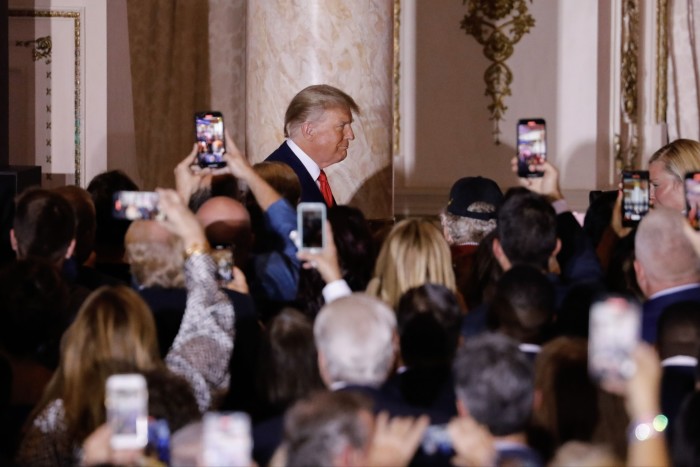
The mood is buoyant. People around me are exchanging stories about the time they met Trump and showing off pictures with him. The former president’s family start to walk in a little before 9pm — Eric and Lara in front, Kushner and Barron behind — and are met with loud cheers. Then the music, “Do you hear the people sing?” from Les Misérables, stops abruptly, and Trump and Melania appear at the entrance. “Gentlemen,” a voice booms over the loudspeakers, “please welcome the next president and first lady of the United States of America, president Donald J Trump, accompanied by Mrs Melania Trump.”
Trump walks up on to the stage and begins his speech. The formal announcement of his 2024 run, which doesn’t come for another 20 minutes, is met with rapturous applause. He seems to be trying to be a more presidential Trump, rather than the Maga-rally Trump, though this looks like it takes a considerable effort. “This is an elegant night and an elegant place, so I’m not going to use the term ‘fake news’.” He puts on a mock-angry voice and adds, “So we’re going to keep it very elegant.”
More than an hour into Trump’s speech, the crowd is beginning to flag. Some supporters have started to leave, and one man who had told me he was a huge Trump fan is still videoing the event, but his eyes are closed. When the speech finally ends, the applause and cheering are thunderous. As the crowd starts to file out, “YMCA” — a Trump rally favourite — comes on. The woman from The Real Housewives does the dance, making the letters Y-M-C-A with her arms.
On the way out, I ask Kramer if she was happy with the way the night went. “Oh yes, you could fly around the world on the energy in here tonight,” she says.
The press pack has to leave, but we find our way upstairs to the patio. Trump is sitting at a table, Eric and Kushner on either side of him. Puccini’s “Nessun Dorma” is playing. Melania appears to have taken Barron back to their private quarters; club members told me that she only sometimes dines with Trump, who everybody says likes to eat in public when he’s here.
A velvet rope is hastily erected around Trump’s table, which is one away from ours, and a waiter brings him a Diet Coke on ice. Other people join him and seem to come and go; the ones I recognise are Kash Patel, his lawyer, and Kimberly Guilfoyle, the former Fox News host and Don Junior’s fiancée, who Kramer says is another “honorary Trumpette”.
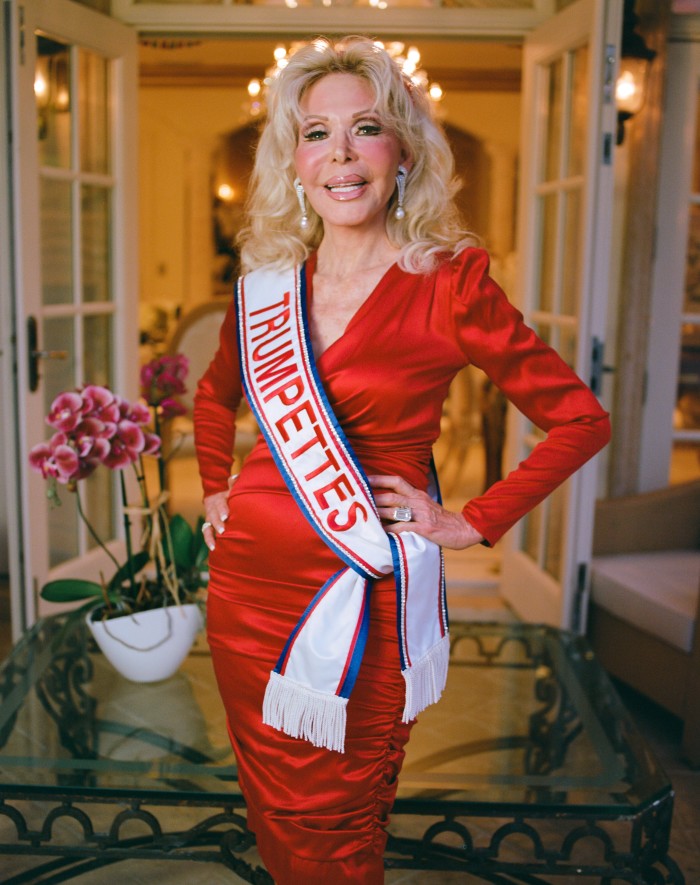
Trump is selecting songs on his iPad. “Oh yes he’s a real music lover. He selects all the music here,” one of the Trumpettes tells me. “He loves to DJ on his iPad.” At one point, the music cuts out entirely for about 20 seconds while he works out what to play next. After “Memory” from the musical Cats, which has been playing so loudly that it has been difficult to talk, Trump starts two songs and stops them abruptly, before settling on “Heroes” by David Bowie. This was also the song that had played as he had walked off stage about half an hour earlier, and I had heard it blasting from Tiffany’s wedding a few days earlier too, while I was out for a walk.
“Why is the music so loud? Is he deaf?” shouts a woman near me. It’s the first time I’ve heard anyone utter anything other than fawning praise inside Trump’s palace.
By about 11pm, Kramer is tired and says it’s time for us to leave. On our way out, Trump, who is only just starting his dinner, spots her: “Toni! Show ’em your ring. Show the ring. Show the ring. Show the ring!”
The women around him ooh and ahh appropriately at the diamond. “I gotta show this ring. Wait, bring your ring, there’s a woman here,” Trump says, getting up and taking Kramer over to a young woman in a tight black mini dress.
Trump goes back to his table, and Kramer and I head towards the exit. Michael Jackson’s “Beat It” is playing as we make our way out. Kramer asks me how I’m getting home, and I say I’ll get an Uber or walk. She insists Jose drop me off in her Rolls-Royce.
As we leave Mar-a-Lago behind, I feel that I’ve come away understanding one thing about Trump’s court: it sustains him. He isn’t Nixon nursing his wounds in a darkened California bungalow. He’s not Carter cheerfully embracing post-presidency house chores. Some of the midterm media coverage seems to wish one of these scenarios is true, or that Trump is otherwise irrelevant, his political career finished. (The Murdoch-owned New York Post’s front-page headline about the speech was: “Florida man makes announcement.”) But up close, theories of a spent Trump don’t hold. Underestimating him now would mean repeating the mistakes his political opponents and the media made in the run-up to the 2016 elections.
In the Rolls, Kramer is still talking passionately. She says she won’t be able to sleep. Normally, it’s the worrying that keeps her awake. Tonight, it’ll be excitement. And thinking about all the work she has to do to help put Trump in power again. “We will be better than we ever were when he gets back in the White House . . . You saw history being made tonight.”
Jemima Kelly is a Financial Times columnist
Follow @FTMag on Twitter to find out about our latest stories first







